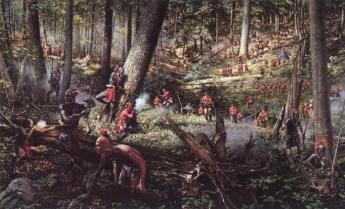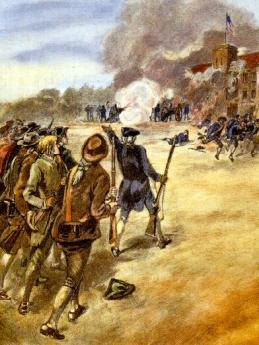Related Topics
Articles of Confederation
The Articles of Confederation were written by John Dickinson, modified by others. Officially unratified for five years, the country was ruled under them in Philadelphia, for thirteen. They taught many lessons, which we sometimes forget we had experienced.
Writing and Ratifying the Articles of Confederation

|
| French-Indian-War |
The Articles of Confederation were written during wartime conditions surrounding the attack on Philadelphia by the British and were initially adopted by the Continental Congress November 15, 1777. The Articles required unanimous ratification by all thirteen states, which was not attained until March 1, 1781, nearly four years later. The last hold-out state was Maryland, still concerned about its western borders. Almost all state borders had been under some degree of challenge during the interval between the French and Indian War and the American Revolution; Maryland still had a grievance. Robert Morris, unofficially running the government of America during the War, used the argument that lack of a stable agreement between the states greatly hampered his efforts to obtain foreign loans, and Maryland finally agreed. The change in status of the states from somebody's private property to common national ownership reduced the importance of defending internal boundaries. Local boundary issues changed from collective state grievances into petty complaints coming from individual landholders, thus exposing that personal quarrels often get dramatized into matters of local patriotism. Provisions of the Articles to permit free movement within the United States, and somewhat freer trade, encouraged more nationalistic viewpoints as the battle of Yorktown showed peace was approaching. The ability of the 1794 Eleventh Amendment to get ratified (prohibiting a citizen from suing another state in Federal Court), uncovers the threat to state power which was hidden in a unification of states and immediately perceived as such by local politicians. It might be noted that New Jersey and Pennsylvania never ratified this amendment, while an overwhelming majority of (Federal) Supreme Court Justices have seemed to favor undermining "state immunity".
The first draft of the Articles was written by the eminent lawyer John Dickinson, who provided for a stronger central government than the states proved ready for. Robert Morris, who finally pushed ratification of the Articles through to completion, had likewise refused to sign the Declaration. In both cases, uneasiness about anarchy and inflation was a major source of hesitation. By observing the positions of these two firm friends, it is possible to guess that the Articles already reflected a conflict between liberty and stability. The forces for prosperous stability temporarily yielded to more Romantic notions of freedom from government restraint, but only during the period of active hostilities with England. The conservatives waited until the evidence in their favor became unanswerable, and pushed the pendulum back toward orderliness, eight years later in 1787. As a timeless example of the two differing approaches, the difference is a stark one between the nation's inability to control Shays Rebellion in 1786 western Massachusetts, and President Washington's fierce restraint of western Pennsylvania's Whiskey Rebellion in 1791. To some extent, Washington's reaction was showmanship, but it was surely true that the United States was beginning to acquire a little taste for George III's viewpoint. Thomas Jefferson also noticed, rejected the concept utterly, and began to prepare his counter-attack.

|
| Shays Rebellion |
Much more than the Articles of Confederation did, for all its proclamation of "perpetuity", The Constitution reflects a firm decision to establish a permanent national government. The Articles required unanimous consent of the states for most actions of Congress, and often resorted to supermajorities of two thirds in other situations. It conducted its affairs through committees of Congress, lacking any national executive or judicial branches. It thus invisibly gave the states which had such agencies a working veto power. Even appointed congressional committees were held on a tight leash. They were reappointed annually and term-limited to three years in any term of six. They voted by states, one vote per state. Although it was not explicitly stated that way, a consequence was the wartime national government had no real power to tax or to enforce its will against an unwilling state. It was a miracle we won that war, but the later obstacles to peaceful prosperity were even more difficult since without an external enemy the consequences were less certain. In case there was any final lingering doubt, any power not expressly stated was to remain with the states. For emphasis, that statement was the second sentence in the document.
On the other hand, the Articles did insist that states should acknowledge the laws of other states, at least in the freedom to travel, to recognize marriages, and to agree to extradition. The Northwest Ordinance enacted under the Articles of Confederation encouraged free public education, trial by jury, and due process. Progress in these areas laid the foundation for further progress under the Constitution and carried with it the implication that the romanticists for liberty did not consider national government power to be a threat in such areas. The view seems to have been that many government powers were harmless, but military power was so particularly dangerous to freedom that it was worth risking some freedom to constrain it. As we will see later, the Constitution was much more precise about what powers an effective government absolutely must have, if it is to defend the nation. And its eyes were more open to the benevolent peacetime potential of a central government. The Constitutional Convention might have achieved such goals by amending the Articles, except for the power which the Articles gave the states to resist the changes. That power must first be crippled by other amendments with a menacing tone. A two-step process of curtailing overall state power, followed by curtailing specified state powers, was a daunting one. Reducing state power would always be resisted more vigorously than pursuing public benefits of some sort. Someone among the Federalists decided that a complicated amendment process would be chancier than just tossing the Articles out in one tumultuous action. Whoever proposed that tactic, eventually succeeded in winning his bet.
Originally published: Thursday, September 06, 2012; most-recently modified: Wednesday, June 05, 2019